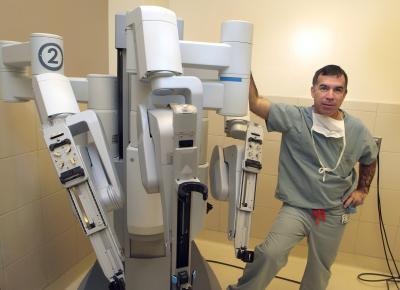AUGUSTA, Ga. – A facelift incision and robotics can help surgeons safely remove a portion of a diseased thyroid from some patients without the characteristic neck scar.
Georgia Health Sciences University surgeons developed the technique utilizing the remote access capabilities of robots, experience gained from another no-neck-scar approach through the armpit and earlier success removing the largest salivary gland from the lower jaw region.
"It is outpatient, it doesn't require a surgical drain and it has the advantage of no neck scar," said Dr. David Terris, Chairman of the GHSU Department of Otolaryngology-Head and Neck Surgery.
The goal was a no-neck-scar technique that's as safe as conventional thyroidectomy, which involves an incision at the base of the neck to gain immediate access to the thyroid, the surgeons report in The Laryngoscope. Two articles detail experiences developing the technique in human cadavers and using it on 14 patients.
"The overarching principle is customizing the surgery to the patient and their disease as opposed to one size fits all. Our advice to patients and surgeons is to do what works best for you," said the studies' corresponding author Terris, who lays out all options for his patients.
Surgery has been done through a multi-inch neck incision for more than 100 years on the thyroid, the endocrine gland just under the Adam's apple that controls the body's metabolic rate. In the last decade, Terris and others have pioneered minimally invasive approaches that can reduce the incision to less than an inch.
In 2004, Terris and colleagues published another Laryngoscope paper that indicated, at least in pigs, the armpit approach worked for avoiding neck scars altogether. While this approach is used selectively in other countries, reports have surfaced of serious side effects such as damage to the brachial plexus, the main nerve to the arm and hand; blood loss; and perforation of the esophagus. After using it on small number of patients, Terris envisioned a more direct, logical route. That's when he thought about his earlier success at removing the large salivary gland through a facelift incision in the hairline.
The daVinci Surgical System, in which surgeons sitting at a console maneuver through tight spaces and around corners, enables remote access, via the armpit or a facelift incision, Terris said. He makes a small incision in the scalp line, burrows under the skin, then moves under the muscle as he nears the thyroid. A retractor developed by Korean surgeons keeps the skin and muscle out of the way while the long, flexible arms and three- dimensional perspective provided by the robot enables removal of up to half of the two-sided thyroid gland. Patients with known cancers or large thyroids are not candidates for this approach but Terris said advances in robotic technology may soon enable surgeons to reach around to access both sides of the thyroid through a single incision.
He notes the hairline approach takes longer and, primarily because of increased time under anesthesia, costs more than minimally invasive surgeries. He's now done more than 30 cases, but greater patient numbers are needed to increase confidence in the safety and feasibility of the approach, he said.
Unlike minimally invasive approaches that are easier on thin patients, the facelift thyroidectomy is actually easier on heavier patients. A common, transient side effect of this approach is temporary, localized numbness because of surgical contact with the nerve that innervates skin in the region.
Problems with the thyroid gland tend to occur in women in their 30s, 40s and 50s. Growths or goiters can result in a hyperactive thyroid gland and jittery, sweaty patients who can't gain weight. Typically if there is a single growth, the surgeons take out that half of the gland, rule out cancer and that is the end of the problem. If it is cancer, the good news is the thyroid can be completely removed, cure rates are high and the gland's function can be replaced by a single, daily pill, Terris said. Known causes of thyroid cancer include radiation exposure.

Dr. David Terris of Georgia Health Sciences University has used robotics and a facelift incision to develop an approach to removing a portion of a diseased thyroid without the characteristic neck scar.
(Photo Credit: Phil Jones/GHSU)